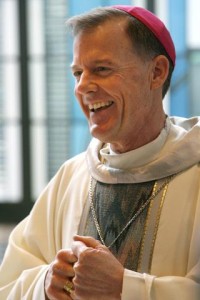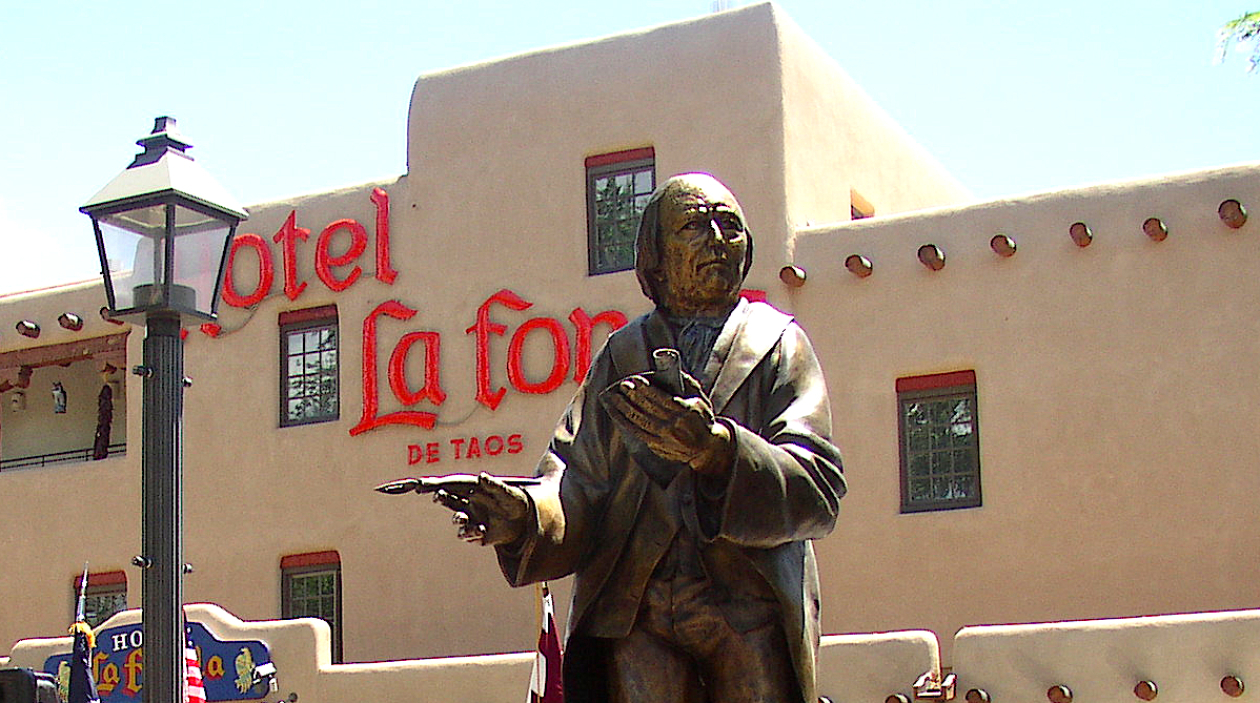 From one “S.F.” to another “S.F.”: On June 4, after having served as Bishop of Utah (Salt Lake Diocese) for eight years, San Francisco-born John C. Wester will become the new Archbishop of Santa Fe. “When Papal Nuncio Pietro Sambi called me from DC to inform me of the appointment, I was stunned, startled, and humbled,” said Bishop-Elect Wester to an American correspondent on a Vatican Radio interview in late April.
From one “S.F.” to another “S.F.”: On June 4, after having served as Bishop of Utah (Salt Lake Diocese) for eight years, San Francisco-born John C. Wester will become the new Archbishop of Santa Fe. “When Papal Nuncio Pietro Sambi called me from DC to inform me of the appointment, I was stunned, startled, and humbled,” said Bishop-Elect Wester to an American correspondent on a Vatican Radio interview in late April.
Utah and New Mexico for centuries have been linked, and that connection will deepen when the new Archbishop will be installed. The Ute peoples, for whom Utah is named, have lived in the area for over a thousand years. The Spanish visited some five centuries ago, and New Mexicans migrated to and settled in Utah for the half-millennium up to the present day, including some of my relatives who worked there seasonally as sheepherders.
In the sixteenth century, the Viceroy of New Spain claimed the great swath of land, including what is now the state of Utah, as part of the Kingdom of Spain’s La Nueva (Custodia de) Mexico. With Mexican independence from Spain in 1821, Utah as part of New Mexico was incorporated into the Federal Republic of Mexico, and remained so for a quarter of a century. The Mormon people came into Mexico’s Utah in 1847, and within three years—without their moving a step– they came to belong to a territory of the United States of America. Forty-six years later, in 1896, and sixteen years before New Mexico, Utah became the forty-fifth state of the Union.
With the appointment of John Charles Wester as the twelfth Archbishop of Santa Fe– succeeding retiring Archbishop James J. Sheehan–the connection between New Mexico and Utah becomes deeper and stronger. The episcopal motto of Archbishop Wester is “Abide in Christ.” Upon his arrival in NM, he will encounter, especially in the northern regions of the Santa Fe Archdiocese, a series of small independently owned adobe buildings called moradas. The Penitent Brotherhood of Nuestro Padre Jesús Nazareno uses them for their religious rites especially during Lent and Holy Week. Some believe the Spanish word morada refers to the color purple in deference to liturgical vestments worn during Lent. Not so. Its true meaning is ABODE–from the Latin verb morari: TO DWELL. In these final weeks of Eastertide, the daily liturgical readings from the Gospel of St. John are replete with references to the theme of “…abide in me…” (e.g., Jn. 15:9-11). To “abide in Christ” is the invitation and challenge of anyone who calls her/himself Christian/Catholic.
In his April interview on Vatican Radio, Bishop Wester acknowledged the deep roots —over four centuries– of the Catholic faith in New Mexico, and its present dynamism. “With forty seminarians, committed lay leadership, the great variety of important activities, the wonderful community of faith is very alive!”
Archbishop Wester is a good fit for Santa Fe. He knows Spanish, and relates well with a variety of ethnic and religious groups such as Filipinos and Vietnamese. His multicultural and interreligious talents include serving on a U.S. Bishops’ Committee on Ch’an/ZEN-Catholic Dialogue, as well as having chaired the Bishop’s Committee on Immigration from 2006 to 2007, and currently chairs the Committee on Communication.
He has been a consistent advocate of social justice and immigration reform. “Resolution to issues of documentation will be found only by respecting cultural diversity while advocating unity. This remains a challenge toward true integration.” In his Vatican Radio interview, the Bishop said, “The Church has a special role to advocate on behalf of immigrants. We are involved at every point: their origin, transit, and destination. The Church is able to counteract negative stereotypes, and can help put a human face on the issue and to highlight its moral and ethical dimensions.”
Bishop Wester’s experience has been broad, and his credentials are excellent. A fourth generation Californian, he was born in San Francisco in 1950. He went to high school seminary, and was ordained for the Archdiocese in the bicentennial year of 1976. First assigned to parish work and then to the work of Catholic formation: campus ministry, high school teacher and president, then Assistant Superintendent of Archdiocesan High Schools. In 1988, then Archbishop of San Francisco and President of the U.S. Bishops’ Conference, Archbishop John Quinn appointed Msgr. Wester to be his priest-secretary. Archbishop Quinn named him in 1993 to his first pastorate of a parish. Four years later, the succeeding Archbishop of San Francisco William Levada appointed Msgr. Wester to be the Vicar for Clergy. The following year in 1998, Pope John Paul II named Wester Auxiliary Bishop of San Francisco, and at the same time Archbishop Levada appointed him as Moderator of the Curia and Vicar General. In March 2007. the next Archbishop of San Francisco, George Niederauer (former Bishop of Salt Lake), installed Bishop Wester as Ordinary (Bishop in Charge) of the Diocese of Salt Lake that encompasses all of Utah.
This San Francisco native brought to Utah an abundance of human qualities that make him as well a good choice for his new post in New Mexico. Priests of his former diocese of Salt Lake praised him. Msgr. T. Fitzgerald said the Bishop is “…kind, compassionate, most generous…[and] open to every person” Fr. Martin Diaz described him as “a passionate shepherd, truly ecumenical, intelligent, and articulate.” Some lay people described him as relaxed, but with a track record of helping the poor and lifting up those in need.
His accomplishments as Bishop of Salt Lake Diocese bode well for his ministry as Archbishop of Santa Fe. He certified sixty-four lay Spanish- speaking ministers last year, and is responsible for the formation of seventeen Spanish speaking permanent deacons who are expected to be ordained within two years. He has addressed the growing number of multi-ethnics within his diocese by bringing in a greater number of multi-cultural clergy. Maria Cruz Gray, Director of Hispanic Ministry in the Diocese, states that Spanish-speaking Catholics populate 95% of diocesan missions! Bishop Wester has responded to the growing number of Hispanics in the Diocese not only with more Spanish or bilingual Masses, but–more importantly–with his “wonderful pastoral outreach and bridge-building between Anglo and Hispanic members of his flock.” His great love for the people is manifested in such things as his support for traditions and a formation program called Instituto Congar (named for progressive French theologian who in the mid-Twentieth Century wrote brilliantly on the role of the laity).
Now Pope Francis has called John Charles Werster to serve as the new Archbishop of Santa Fe. Skills yet to be sharpened for coming challenges include relating well with the unique cultural aspects of Native Americans and the proud Spanish heritage of native New Mexicans. In an interview with Vatican Radio, Archbishop-Elect John Wester projected a properly humble attitude for coming into his new Archdiocese. “I recognize their dynamism in the faith, and my first priority will be to LISTEN.” Father Javier Virgen, Vicar for Hispanic Affairs of Salt Lake Diocese, vouched for the new Archbishop’s “incredible capacity to listen,” and lauded his great compassion as well as disposition to always be with the people.
I sincerely hope those qualities will incline the new Archbishop of Santa Fe to encourage long-time efforts–since the early episcopate of +Robert Sanchez– to posthumously rehabilitate Padre Antonio José Martínez from ecclesiastical censures that I believe were unjustly imposed in 1856 and 1858.
Archbishop-Elect Wester, appointed as new Archbishop of Santa Fe at the brink of 65 years of age, will have a full decade before being obliged to offer his resignation to the Holy Father. May his assignment be a blessed and fruitful time during which our loving Lord will bless his new ministry. We invoke the Holy Spirit to illumine and strengthen him in all of its aspects. We pray that Blessed Mary–through the double invocation of Nuestra Señora de Guadalupe y La Inmaculada Concepción, both so dear to Padre Martínez–be with him “for the whole ride” to serve well the local church of Santa Fe. “So far, I have been on an emotional roller coaster, but will do my best,” he said during his late April interview with Vatican Radio.
You may Tweet congratulations to the new Archbishop-Elect of Santa Fe (@BishopWester ) or write to him in care of either his present or future address: Most Rev. John C. Wester – 27 C Street – Salt Lake City, Utah 84103/or at 4000 St Josephs Dr, NW – Albuquerque, NM 87120.
Census map of 1830: Territory—together with most of Latin America—that the Viceroy of Spain in the sixteenth century claimed as New Spain. From 1821 until 1846, after Mexico’s independence from Spain, the Federal Republic of Mexico claimed these extensive territories. Through “Manifest Destiny” and by war ending with the 1848 Treaty of Guadalupe Hidalgo, Mexico ceded the large swath of almost half its territory to the USA. The land includes all of Alta California, Nevada, Utah, Arizona, New Mexico, and the great state of Texas. It also includes the western half of Colorado, a piece of southwestern Wyoming, a sliver of southwestern Kansas, and the Panhandle of northwestern Oklahoma.

